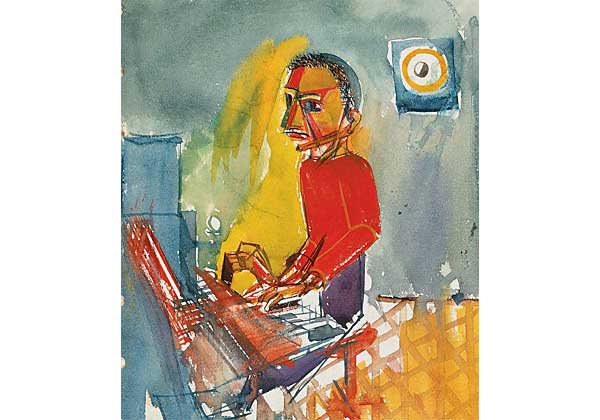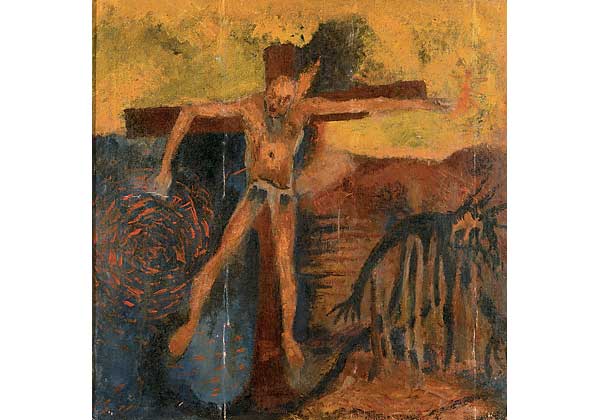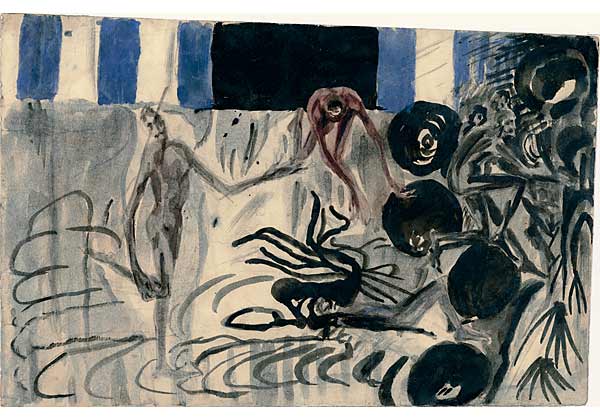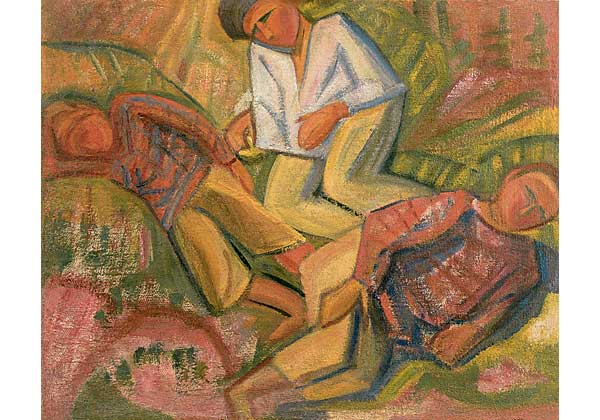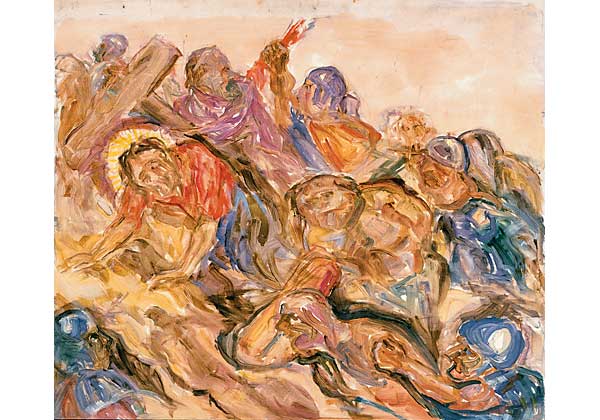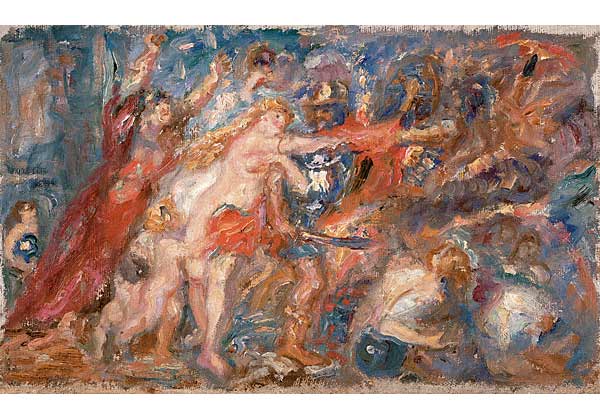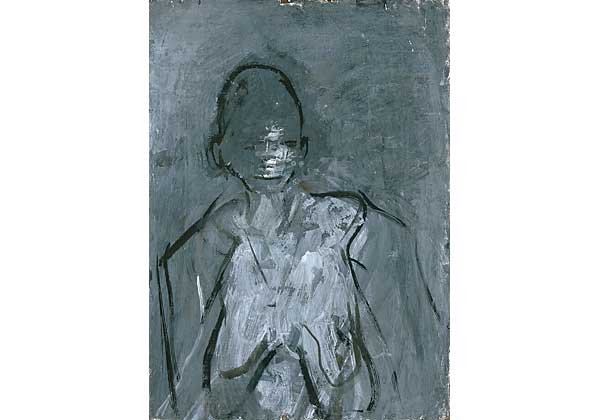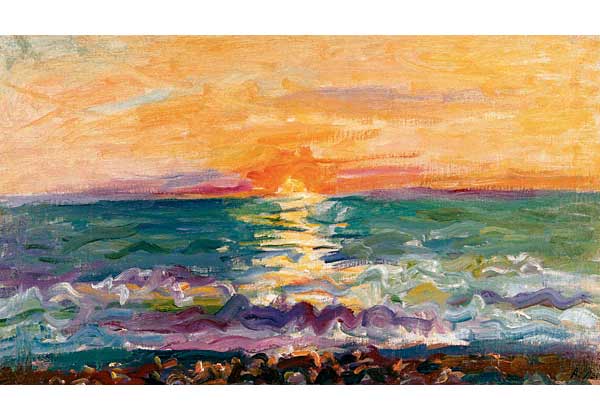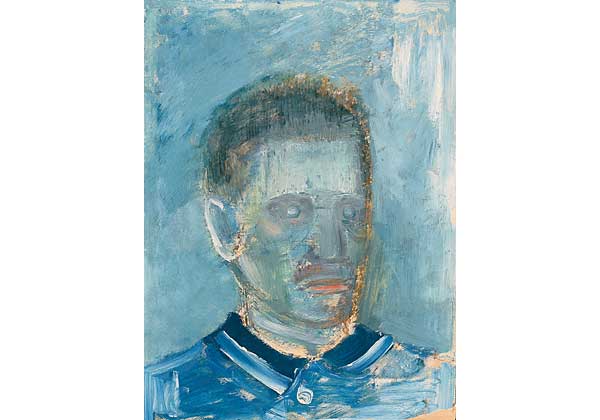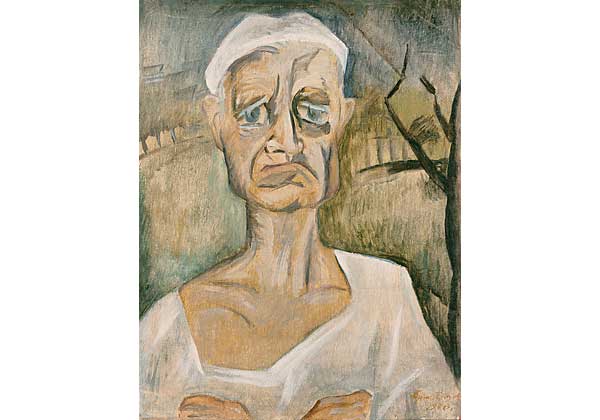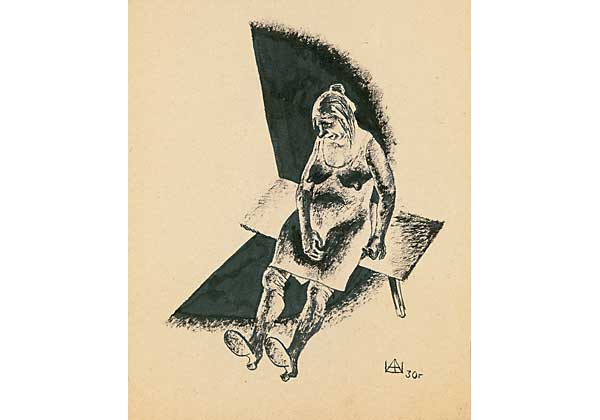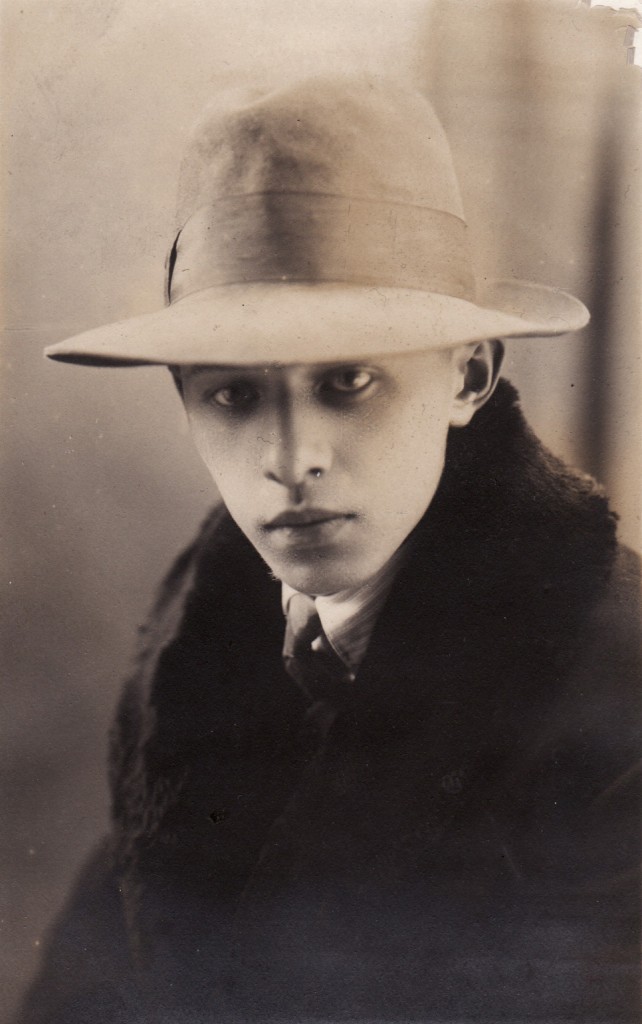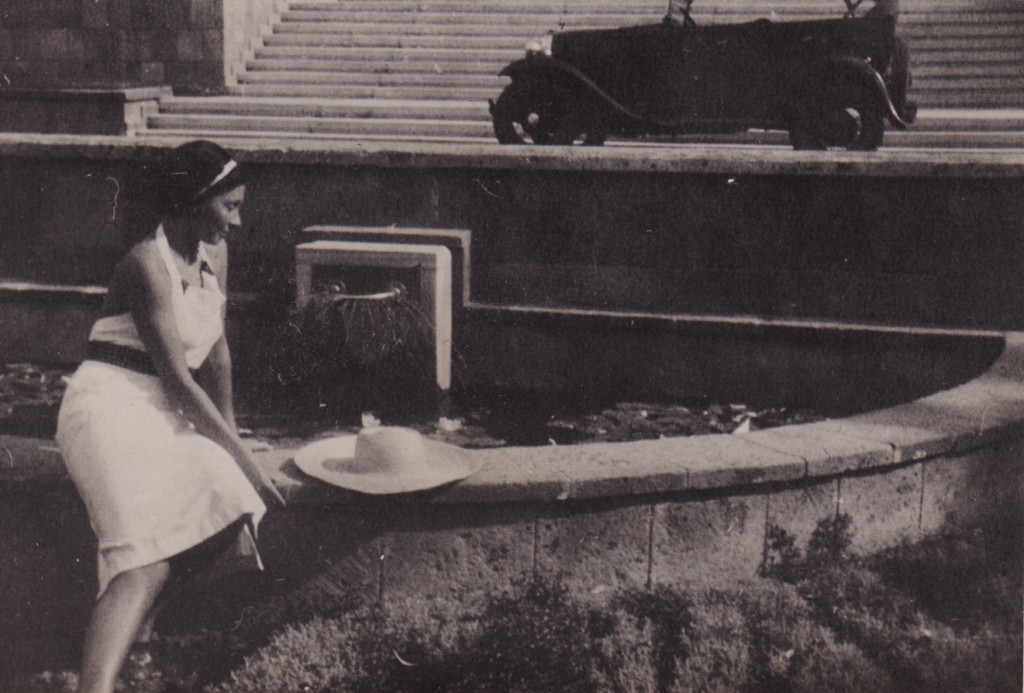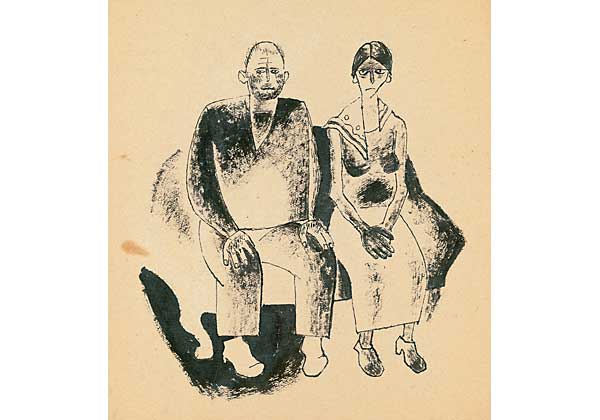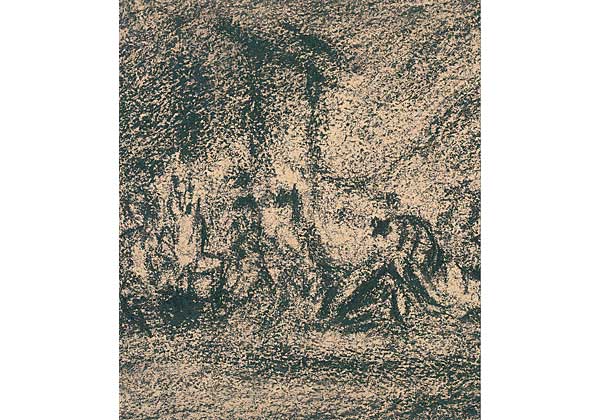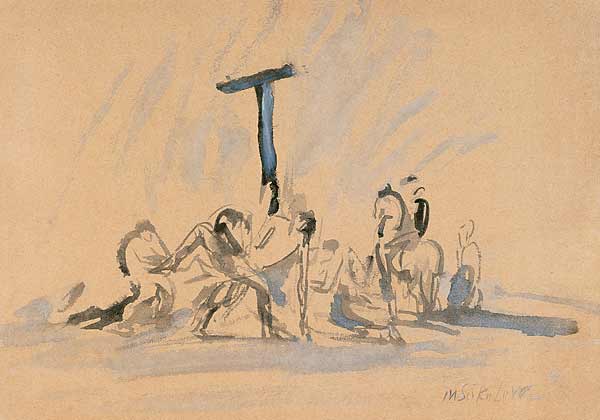Books Expressionism
-
Alexander Labas
Labas, Alexander Arkadievich
(b. 1900 Smolensk – d. 1983 Moscow)
Painter, graphic artist and theater designer
1907–1908 – Studied at the studio of V. Mushketov in Smolensk.
1912– 1917 – Studied at Moscow Stroganov Higher College of Art and Industry under S. Noakovsky, F. Fyodorovsky and D. Shcherbinovsky, and at the same time at the studios of F. Rerberg and I. Mashkov.
1918 – Entered SVOMAS [The State Free Art Studios] in Moscow under P. Konchalovsky and F. Malyavin. Took part in exhibitions beginning in 1921, including: 1929 – USSR Art Exhibitions in New York, Philadelphia, Boston and Detroit; 1937 – the World Fair in Paris; 1939 – the International Exhibition in New York; 1976 – personal exhibition
in Moscow.
1925–1932 – Co-founder and member of OST [Society for Easel Painting].
1920–1921 – Taught painting at the State Art Studios in Yekaterinburg.
1924–1929 – Taught painting and chromatics at Vkhutemas-Vkhutein [The Higher Art and Technical Studios and Institute] in Moscow.
1930s – Worked on panoramic and dioramic designs and theater scenery.
“I would like to live to the year 2000, but only if I could retain the ability to see, to feel, and to experience, which is already very difficult, almost impossible. But I’d like to at least dream of living through the entire 20th century, the most wonderful century ever, a century full of astounding discoveries and revolutions in life, science, technology, and art. And all this happened right before my eyes. Everything was a real experience, and I participated in much of it myself What I’m sure of is this: with every coming decade, my work will be better and better understood, and in, say, 50 or 100 years, it will ring out at flail strength. Everyone will see in my work our own time; I think I perceived it very well and was able to discern the meaning of the very complicated events of our breathtaking 20th century. I was born at an amazingly precise time: this century fits me like no other century.”
Alexander Labas, Moscow, 1980s
Gossudarstvennyi Russky muzei predstavlyaet: Aleksandr Labas. Vospominaniya [The state Russian Museum Presents: Alexander Labas. Memoirs] /Almanakh [Almanac], no. 86. SPb.: Palace Editions, 2004. P. 123.
-
Boris Golopolosov
Golopolosov, Boris Alexandrovich
(b. 1900 Arkhangelsk – d. 1983 Moscow)
Painter and graphic artist
1919–1925 – Studied in A. Shevchenko’s class at Vkhutemas (the Higher Art and Technical Studios).
1923 – Had his exhibition debut by participating in the First Exhibition of Easel Painters at the Museum of Fine Arts in Moscow.
1926–1930 – Member of the Painters Guild.
1930 – Participant in an exhibition entitled “Socialist Construction in Soviet Art.”
1933 – Took part in an exhibition entitled “Artists of the RSFSR [Russian Soviet Federative Socialist Republic] During the Past 15 Years” in Moscow.
1934 – Participant in the Exhibition of Beginner Artists of Moscow. Since then Golopolosov showed none of his works at any exhibition until 1977.
(1900, Архангельск – 1983, Москва)
Живописец, график
1919–1925 учился в Высших художественно-технических мастерских (Вхутемас) в классе А. Шевченко.
1923 впервые экспонировал свои произведения на «1-й Выставке станковых художников» в Музее изящных искусств в Москве.
1926–1930 член объединения «Цех живописцев».
1930 участник выставки «Социалистическое строительство в Советском искусстве».
1933 экспонент выставки «Художники РСФСР за XV лет» в Москве,
1934 – «Выставки начинающих молодых художников г. Москвы». С этого времени работы художника не выставлялись до 1977 года.
-
Boris Golopolosov
Golopolosov, Boris Alexandrovich
(b. 1900 Arkhangelsk – d. 1983 Moscow)
Painter and graphic artist
1919–1925 – Studied in A. Shevchenko’s class at Vkhutemas (the Higher Art and Technical Studios).
1923 – Had his exhibition debut by participating in the First Exhibition of Easel Painters at the Museum of Fine Arts in Moscow.
1926–1930 – Member of the Painters Guild.
1930 – Participant in an exhibition entitled “Socialist Construction in Soviet Art.”
1933 – Took part in an exhibition entitled “Artists of the RSFSR [Russian Soviet Federative Socialist Republic] During the Past 15 Years” in Moscow.
1934 – Participant in the Exhibition of Beginner Artists of Moscow. Since then Golopolosov showed none of his works at any exhibition until 1977.
(1900, Архангельск – 1983, Москва)
Живописец, график
1919–1925 учился в Высших художественно-технических мастерских (Вхутемас) в классе А. Шевченко.
1923 впервые экспонировал свои произведения на «1-й Выставке станковых художников» в Музее изящных искусств в Москве.
1926–1930 член объединения «Цех живописцев».
1930 участник выставки «Социалистическое строительство в Советском искусстве».
1933 экспонент выставки «Художники РСФСР за XV лет» в Москве,
1934 – «Выставки начинающих молодых художников г. Москвы». С этого времени работы художника не выставлялись до 1977 года.
-
Boris Golopolosov
Golopolosov, Boris Alexandrovich
(b. 1900 Arkhangelsk – d. 1983 Moscow)
Painter and graphic artist
1919–1925 – Studied in A. Shevchenko’s class at Vkhutemas (the Higher Art and Technical Studios).
1923 – Had his exhibition debut by participating in the First Exhibition of Easel Painters at the Museum of Fine Arts in Moscow.
1926–1930 – Member of the Painters Guild.
1930 – Participant in an exhibition entitled “Socialist Construction in Soviet Art.”
1933 – Took part in an exhibition entitled “Artists of the RSFSR [Russian Soviet Federative Socialist Republic] During the Past 15 Years” in Moscow.
1934 – Participant in the Exhibition of Beginner Artists of Moscow. Since then Golopolosov showed none of his works at any exhibition until 1977.
(1900, Архангельск – 1983, Москва)
Живописец, график
1919–1925 учился в Высших художественно-технических мастерских (Вхутемас) в классе А. Шевченко.
1923 впервые экспонировал свои произведения на «1-й Выставке станковых художников» в Музее изящных искусств в Москве.
1926–1930 член объединения «Цех живописцев».
1930 участник выставки «Социалистическое строительство в Советском искусстве».
1933 экспонент выставки «Художники РСФСР за XV лет» в Москве,
1934 – «Выставки начинающих молодых художников г. Москвы». С этого времени работы художника не выставлялись до 1977 года.
-
Boris Golopolosov
Golopolosov, Boris Alexandrovich
(b. 1900 Arkhangelsk – d. 1983 Moscow)
Painter and graphic artist
1919–1925 – Studied in A. Shevchenko’s class at Vkhutemas (the Higher Art and Technical Studios).
1923 – Had his exhibition debut by participating in the First Exhibition of Easel Painters at the Museum of Fine Arts in Moscow.
1926–1930 – Member of the Painters Guild.
1930 – Participant in an exhibition entitled “Socialist Construction in Soviet Art.”
1933 – Took part in an exhibition entitled “Artists of the RSFSR [Russian Soviet Federative Socialist Republic] During the Past 15 Years” in Moscow.
1934 – Participant in the Exhibition of Beginner Artists of Moscow. Since then Golopolosov showed none of his works at any exhibition until 1977.
(1900, Архангельск – 1983, Москва)
Живописец, график
1919–1925 учился в Высших художественно-технических мастерских (Вхутемас) в классе А. Шевченко.
1923 впервые экспонировал свои произведения на «1-й Выставке станковых художников» в Музее изящных искусств в Москве.
1926–1930 член объединения «Цех живописцев».
1930 участник выставки «Социалистическое строительство в Советском искусстве».
1933 экспонент выставки «Художники РСФСР за XV лет» в Москве,
1934 – «Выставки начинающих молодых художников г. Москвы». С этого времени работы художника не выставлялись до 1977 года.
-
Anton Chirkov
Chirkov, Anton Nikolayevich
(b. 1902 Village of Napolny Vyas, Penza guberniya – d. 1946 village of Zhegalovo, Moscow region)
Painter and graphic artist
1920 – Joined the Penza Art School, where he studied in A. Shturman’s studio.
1922 – Moved to Moscow and was enrolled in Vkhutemas (the Higher Art and Technical Studios), where he studied in the studios of A. Osmyorkin, I. Mashkov and P. Konchalovsky.
1925 – Had his work “Loaves of Bread” shown at the World’s Fair in Paris.
1926 – Took part in an exhibition of the Bytiye (Existence) association of artists.
1927 – Graduated from Vkhutein (former Vkhutemas), took part in an exhibition of the Krylo (Wing) association.
1928 – Took part in an exhibition marking the tenth anniversary of the Bolshevik revolution and in an exhibition of the Moscow Artists Society (OMKh), taught at the Ryazan Art College.
1930 – Began to teach at the Memory of 1905 Moscow Regional Art School (MOKhU).
1931 – Sent to the northern Russian city of Murmansk for a working visit that resulted in one of his best-known works, “Northern Venus.”
1937 – Personal exhibitions at the MOKhU and the Hammer and Sickle cultural center in Moscow.
1941 – Was drafted into the armed forces.
1942 – Demobilized, had a personal exhibition at the Artists House at 15 Verkhnyaya Maslovka Street.
1945–1946 – Painted frescoes in the Church of St. Nicholas in Zhegalovo, Moscow region.
-
Anton Chirkov
Chirkov, Anton Nikolayevich
(b. 1902 Village of Napolny Vyas, Penza guberniya – d. 1946 village of Zhegalovo, Moscow region)
Painter and graphic artist
1920 – Joined the Penza Art School, where he studied in A. Shturman’s studio.
1922 – Moved to Moscow and was enrolled in Vkhutemas (the Higher Art and Technical Studios), where he studied in the studios of A. Osmyorkin, I. Mashkov and P. Konchalovsky.
1925 – Had his work “Loaves of Bread” shown at the World’s Fair in Paris.
1926 – Took part in an exhibition of the Bytiye (Existence) association of artists.
1927 – Graduated from Vkhutein (former Vkhutemas), took part in an exhibition of the Krylo (Wing) association.
1928 – Took part in an exhibition marking the tenth anniversary of the Bolshevik revolution and in an exhibition of the Moscow Artists Society (OMKh), taught at the Ryazan Art College.
1930 – Began to teach at the Memory of 1905 Moscow Regional Art School (MOKhU).
1931 – Sent to the northern Russian city of Murmansk for a working visit that resulted in one of his best-known works, “Northern Venus.”
1937 – Personal exhibitions at the MOKhU and the Hammer and Sickle cultural center in Moscow.
1941 – Was drafted into the armed forces.
1942 – Demobilized, had a personal exhibition at the Artists House at 15 Verkhnyaya Maslovka Street.
1945–1946 – Painted frescoes in the Church of St. Nicholas in Zhegalovo, Moscow region.
-
Magdalina Verigo
(b. 1891 St. Petersburg – d. 1994 Moscow)
Painter, poet and translator
Taught by V. Sokolovich at the Odessa Art College.
1912–1913 – Studied at the Academie Ranson in Paris.
1912 – Her poetry began to be published in magazines and almanacs.
1913 – Began to take part in exhibitions.
1915 – Studied at I. Mashkov’s studio in Moscow.
1917–1920 – Taught at the Perm Higher Art and Industrial Studios, which were renamed Art College in 1921.
1920–1921 – Headed the fine arts section of the Tomsk education authority.
1921–1925 – Resumed teaching in Perm.
1926 – Moved to Moscow. Since then she devoted a great deal of time to painting. Verigo corresponded with Russian philosopher, philologist and culturologist A. Losev, wrote memoirs about Russian poet A. Blok, and is the author of a study of the work of Latvian sculptor K. Zale.
-
Sergei Romanovich
Sergei Mikhailovich Romanovich
(1894, Moscow – 1968, Moscow)
Painter and graphic artist
1894 was born on September 11 in Moscow to the family of Mikail Mikailovich Romanovich, an officer in the Opekunsky Soviet (Board of Trustees) under the Empress’s personal direction
1909 enrolled in the general education department of the Moscow School of Painting, Sculpture and Architecture (MUZhVZ)
1912 studied in the painting department of MUZhVZ. S. M. Romanovich’s instructors at the school were A. Arkipov, A. Baksheev, K. Korovin, P. Kuznetsov, S. Malyutin and L. Pasternak. In that same year he joined M. Larionov’s Krug Soratnikov (Circle of Brothers-in-Arms)
1913 participated in an exhibition by M. Larionov’s group Mishen (Target)
1914 participated in the exhibition No. 4. After the start of the war, S. M. Romanovich was drafted to the army but was soon discharged.
1915 gave a solo exhibition at MUZhVZ at which S. M. Romanovich presented his abstract works
1918 completed his education at MUZhVZ and taught at Proletkult’s Moscow fine arts studio
1920 began teaching at the Voronezh Higher Art and Technical Studios (Vorkutemas)
1921 joined the artists’ and poets’ federation Art is Life (Makovets). Took part in the federation’s exhibitions in 1922, 1924 and 1925.
1922 became a Vkutemas professor in Moscow; in that same year he published an article titled “On Realism” in the second issue of the journal Makovets.
1928 joined the Society of Moscow Artists (OMKh)
1929 participated in an exhibition by the artistic association The Four Arts; beginning in this year he taught painting at Rabfak (Workers’ Faculty) in Moscow
1935 began working in the USSR Architecture Academy’s monumental painting studio where he remained until 1948
1950 was an instructor in the ornamental department of the Moscow Higher School of Arts and Industry
1968 died in Moscow on November 21.
-
Sergei Romanovich
Sergei Mikhailovich Romanovich
(1894, Moscow – 1968, Moscow)
Painter and graphic artist
1894 was born on September 11 in Moscow to the family of Mikail Mikailovich Romanovich, an officer in the Opekunsky Soviet (Board of Trustees) under the Empress’s personal direction
1909 enrolled in the general education department of the Moscow School of Painting, Sculpture and Architecture (MUZhVZ)
1912 studied in the painting department of MUZhVZ. S. M. Romanovich’s instructors at the school were A. Arkipov, A. Baksheev, K. Korovin, P. Kuznetsov, S. Malyutin and L. Pasternak. In that same year he joined M. Larionov’s Krug Soratnikov (Circle of Brothers-in-Arms)
1913 participated in an exhibition by M. Larionov’s group Mishen (Target)
1914 participated in the exhibition No. 4. After the start of the war, S. M. Romanovich was drafted to the army but was soon discharged.
1915 gave a solo exhibition at MUZhVZ at which S. M. Romanovich presented his abstract works
1918 completed his education at MUZhVZ and taught at Proletkult’s Moscow fine arts studio
1920 began teaching at the Voronezh Higher Art and Technical Studios (Vorkutemas)
1921 joined the artists’ and poets’ federation Art is Life (Makovets). Took part in the federation’s exhibitions in 1922, 1924 and 1925.
1922 became a Vkutemas professor in Moscow; in that same year he published an article titled “On Realism” in the second issue of the journal Makovets.
1928 joined the Society of Moscow Artists (OMKh)
1929 participated in an exhibition by the artistic association The Four Arts; beginning in this year he taught painting at Rabfak (Workers’ Faculty) in Moscow
1935 began working in the USSR Architecture Academy’s monumental painting studio where he remained until 1948
1950 was an instructor in the ornamental department of the Moscow Higher School of Arts and Industry
1968 died in Moscow on November 21.
-
Georgiy Shchetinin
Georgiy Aleksandrovich Shchetinin
(1916, Moscow – 2004, Moscow)
Painter, graphic artist and pedagogue
1916 was born in Moscow
1933 graduated from civil engineering school and worked as a constructor
1934 began attending evening drawing and painting classes at the First Automotive Plant’s workers’ studio under the direction of Timofei Ermilovich Pustovalov; to the end of his days, Shchetinin regarded Pustovalov as his sole teacher.
1937 enrolled in the artistic department at the Moscow Textile Institute
1940 enrolled in the graphic department at the Surikov Moscow State Artistic Institute (MGKhI); during this time, until 1941, he continued to attend classes at T. E. Pustovalov’s studios.
An important event in this year was his bi-monthly trips to Leningrad where G. A Shchetinin had the opportunity to attend Pavel Nikolaevich Filonov’s workshop; Shchetinin later published his recollections of this meeting in the journal Our Heritage (No. 8, 1988)
1941 evacuated with the institute to Samarkand
1944 returned to Moscow
1946 defended his graduation thesis, for which he prepared a series of etchings on the topic “Under Occupation”
1947 began teaching, which he did for the rest of his life; in that same year he was admitted to the Artists’ Union
1948 began work in the field of graphic design at the Graphic Arts Combine and at the Special Artistic and Drafting Bureau of Mosgorsovnarkhoz (Soviet of the National Economy for the Moscow City Economic District), where he acted as head draftsman.
Beginning at this same time he worked extensively as a book artist at the publishing houses Goslitizdat (which later became Khudozhestvennaya Literatura), Mir, Progress and others. He designed a total of 80 books
1965 began teaching at the Surikov MGKhI
2000 a G. A. Shchetinin solo exhibition was held
2004 passed away in Moscow
-
Georgiy Shchetinin
Georgiy Aleksandrovich Shchetinin
(1916, Moscow – 2004, Moscow)
Painter, graphic artist and pedagogue
1916 was born in Moscow
1933 graduated from civil engineering school and worked as a constructor
1934 began attending evening drawing and painting classes at the First Automotive Plant’s workers’ studio under the direction of Timofei Ermilovich Pustovalov; to the end of his days, Shchetinin regarded Pustovalov as his sole teacher.
1937 enrolled in the artistic department at the Moscow Textile Institute
1940 enrolled in the graphic department at the Surikov Moscow State Artistic Institute (MGKhI); during this time, until 1941, he continued to attend classes at T. E. Pustovalov’s studios.
An important event in this year was his bi-monthly trips to Leningrad where G. A Shchetinin had the opportunity to attend Pavel Nikolaevich Filonov’s workshop; Shchetinin later published his recollections of this meeting in the journal Our Heritage (No. 8, 1988)
1941 evacuated with the institute to Samarkand
1944 returned to Moscow
1946 defended his graduation thesis, for which he prepared a series of etchings on the topic “Under Occupation”
1947 began teaching, which he did for the rest of his life; in that same year he was admitted to the Artists’ Union
1948 began work in the field of graphic design at the Graphic Arts Combine and at the Special Artistic and Drafting Bureau of Mosgorsovnarkhoz (Soviet of the National Economy for the Moscow City Economic District), where he acted as head draftsman.
Beginning at this same time he worked extensively as a book artist at the publishing houses Goslitizdat (which later became Khudozhestvennaya Literatura), Mir, Progress and others. He designed a total of 80 books
1965 began teaching at the Surikov MGKhI
2000 a G. A. Shchetinin solo exhibition was held
2004 passed away in Moscow
-
Alexandra Yakusheva
Aleksandra Ivanovna Yakusheva
(1900, the village Zhivodovka in the Kaluga Governorate – 1986, Moscow)
Painter and graphic artist1900 was born to a peasant family
1920 moved to Moscow and enrolled at the Rabfak (Workers’ Faculty) of the Arts run by Vkhutemas
1924 graduated from Rabfak
1925 enrolled in the painting department of Vkhutemas; attended R. R. Falk’s, A. D. Drevin’s, K. N. Istomin’s and S. V. Gerasimov’s workshops
1928 took part in OMAKhRR’s first exhibition in Moscow
1929 took part in the AKhR’s eleventh exhibition Art to the Masses in Moscow
1930 took a creative trip to Azerbaijan
1932 joined MOSSKh, was a member of its administration and chairperson of the Vsekokhudozhnik review commission, engaged in pedagogical work
1933 participated in the exhibition Fifteen Years of the RKKA
1934 participated in an exhibition of young, novice artists of Moscow
1941 left in the evacuation to Kirgizia where she took part in republic-wide exhibitions
After returning to Moscow she participated extensively in exhibitions
1986 passed away
-
Alexander Labas
Labas, Alexander Arkadievich
(b. 1900 Smolensk – d. 1983 Moscow)
Painter, graphic artist and theater designer
1907–1908 – Studied at the studio of V. Mushketov in Smolensk.
1912– 1917 – Studied at Moscow Stroganov Higher College of Art and Industry under S. Noakovsky, F. Fyodorovsky and D. Shcherbinovsky, and at the same time at the studios of F. Rerberg and I. Mashkov.
1918 – Entered SVOMAS [The State Free Art Studios] in Moscow under P. Konchalovsky and F. Malyavin. Took part in exhibitions beginning in 1921, including: 1929 – USSR Art Exhibitions in New York, Philadelphia, Boston and Detroit; 1937 – the World Fair in Paris; 1939 – the International Exhibition in New York; 1976 – personal exhibition
in Moscow.
1925–1932 – Co-founder and member of OST [Society for Easel Painting].
1920–1921 – Taught painting at the State Art Studios in Yekaterinburg.
1924–1929 – Taught painting and chromatics at Vkhutemas-Vkhutein [The Higher Art and Technical Studios and Institute] in Moscow.
1930s – Worked on panoramic and dioramic designs and theater scenery.
“I would like to live to the year 2000, but only if I could retain the ability to see, to feel, and to experience, which is already very difficult, almost impossible. But I’d like to at least dream of living through the entire 20th century, the most wonderful century ever, a century full of astounding discoveries and revolutions in life, science, technology, and art. And all this happened right before my eyes. Everything was a real experience, and I participated in much of it myself What I’m sure of is this: with every coming decade, my work will be better and better understood, and in, say, 50 or 100 years, it will ring out at flail strength. Everyone will see in my work our own time; I think I perceived it very well and was able to discern the meaning of the very complicated events of our breathtaking 20th century. I was born at an amazingly precise time: this century fits me like no other century.”
Alexander Labas, Moscow, 1980s
Gossudarstvennyi Russky muzei predstavlyaet: Aleksandr Labas. Vospominaniya [The state Russian Museum Presents: Alexander Labas. Memoirs] /Almanakh [Almanac], no. 86. SPb.: Palace Editions, 2004. P. 123.
-
Yefrosiniya Yermilova-Platova
Yermilova-Platova, Yefrosiniya Fedoseyevna
(b. 1895 Village of Kamenka, Tavricheskaya guberniya – d. 1974 Moscow)
Painter, graphic artist
1914 – Entered the Moscow University (Department of History and Philology).
1914–1916 – Studied drawing under K. Yuon and I. Dudin.
1917–1918 – Attended I. Mashkov’s workshop.
1919 – Participated in the founding of an artistic studio, museum and poster workshop in Nikopol.
1919–1921 – Worked in the art section of the Crimean National Department of Education in Simferopol under Ya. Tugendhold.
Took part in exhibitions beginning in 1919, including: 1919 – exhibition of Kherson artists; 1932 – Artists of the RSFSR [Russian Soviet Federative Socialist Republic] During the Past 15 Years (Leningrad); 1934 – exhibition at the Club of Master Artists (Moscow) together with her husband, F. Platov; 1939, 1944 – personal exhibitions.
1949 – Expelled from the MOSKh [Moscow Artists’ Union].
1992 – posthumous personal exhibition at the Kuntsevo Exhibition Hall (Moscow).
“I don’t remember the exact year, but the exhibition by Goncharova, Larionov, and Burlyuk in Kherson left an indelible impression on my artwork for the rest of my life. I always really enjoyed primitivists such as Giotto, Pieter Bruegel, and contemporary French painters.”
The sources of her series of paintings Faces and Streets, At the Barber Shop, and Themes from Old Russian Frescoes are evident: folk painting, sign boards, popular prints, and icons. But these merely served as starting points for her work. c.> The unlimited fantasy, spontaneous self-expression, and organic primitivism of Yermilova-Platova sewed as a trustworthy antidote to the poison of stylization and even imitation. Her motto was “I paint everything I love.”
“In my childhood, I looked after flowers.” Flowers in the field and in the garden, exotic flowers, later became the dominant motif of her still lifes.
“The beauty of the Dnieper River has left its imprint on me for my entire life: its extraordinary high waters, riding in rowboats, sailboats and other small crafts into the city of Nikopol during both stormy and calm weather.” The word “imprint” seems to be very precise, for it is unlikely that Yermilova-Flatova painted her Kamenka-on-the-Dnieper scenes directly from life, year in, year out, in spring and in fall. It rather seems that she was traveling along the paths ingrained in her memory, again and again experiencing the feeling of being on the boundless waters or steppe, with the sky overhead. Her space is magnetic; it is made of “flying matter,” the condensation and dispersal of light, and is organized “by lines that express the crystal clarity of the details and a slightly indistinct landscape.” The artist’s ideal is “the Japanese linethat can be hard like metal and soft like down. It conveys a calm balance and a swift motion. The line is maintained both on the plane and in space.”
O. Roytenberg. Neuzheli kto-to vspomnit, chto my byli… Iz istorii khudozhestvennoy zhizni. 1925—1935 [Can It be that Someone Remembers that we Existed… From the History of Artistic Life: 1925—1935]. M.: Galart, 2004. Pp. 370, 372—373.
-
Arseny Schultz
Arseny Leonidovich Schultz
(1910, Tallin – 1976, Moscow)
Painter and graphic artist
Was born on December 23, 1910 in the city Tallin
1924 created his first paintings and works of graphic art
1925 visited Kadrovsky’s studio in Moscow
1926 enrolled in geodetics courses in Moscow
Beginning in 1928 worked as an artist for book and magazine publishers
1929 on June 20 the Khamovniki District section of the Moscow Governorate Department of Public Education presented him certification that he had passed courses in geodetics
In that same year he began attending classes at the VKhUTEIN Rabfak (Workers’ Faculty) of the Arts.
1932 married Adele Pavlovna Shik on March 1
1933 enrolled in the Moscow Architectural Institute
1937 on July 3 graduated from the institute “with an architect’s qualification,” and, at this same time, began research work in the field of new print graphics technologies
1941 was drafted for military service, worked as an artist at the magazines Ogonyok, Krasnoarmeets and Krasnoflotets
1942 was afflicted with severe typhus from March through April
1942 – 1943 served in the military and worked in Yoshkar-Ola at the print shop for the newspaper Sniper as typesetter and layout artist
1944 in October was discharged to the reserves and at this time began working in Project Management at the USSR Academy of the Sciences headed by A. V. Shchusev
1945 on September 12 joined the Moscow Section of the Union of Soviet Artists; beginning in this year worked extensively a book artist for the publisher Detgiz.
1946 on January 10 applied for an author’s certificate for his work “Means of Manually Printing Engravings or Similar Images Using Dry Ink with Thermal Application of the Imprint,” author’s certificate No. 73813 dd. January 1949
1946 took part in an exhibition of the works by artists that participated in World War II, held in the MOSSKh exhibition hall
1947 on December 15 applied for an author’s certificate to be issued for the “Device for Casting Type Slugs from Contone Matrices Using a Linotype with Application of a Photographic Element.” On February 3, 1948 he received certificate No. 373016 on exclusive rights to the Patent from the Directorate of the Committee on Inventions and Discoveries under the Council of Ministers of the USSR.
In this same year he took part in an exhibition of graphic arts (color engraving on linoleum) at the Russian Museum where he displayed a portrait of Lev Tolstoy
1948 was arrested on August 8 on the basis of Articles 17-58-8; 58-10; and 58-11. He was held in the MGB (Ministry for State Security) prison and was tried by a special council under the MGB on May 14, 1949.
1956 was released on January 4 according to the resolution of the Military Collegium of the Supreme Court of the USSR dd. August 4, 1956; the case was dismissed “due to absence of a crime”
from 1957 onwards worked as an artist at various publishers; he designed 56 books
1976 died in Moscow on September 23.
-
Arseny Schultz
Arseny Leonidovich Schultz
(1910, Tallin – 1976, Moscow)
Painter and graphic artist
Was born on December 23, 1910 in the city Tallin
1924 created his first paintings and works of graphic art
1925 visited Kadrovsky’s studio in Moscow
1926 enrolled in geodetics courses in Moscow
Beginning in 1928 worked as an artist for book and magazine publishers
1929 on June 20 the Khamovniki District section of the Moscow Governorate Department of Public Education presented him certification that he had passed courses in geodetics
In that same year he began attending classes at the VKhUTEIN Rabfak (Workers’ Faculty) of the Arts.
1932 married Adele Pavlovna Shik on March 1
1933 enrolled in the Moscow Architectural Institute
1937 on July 3 graduated from the institute “with an architect’s qualification,” and, at this same time, began research work in the field of new print graphics technologies
1941 was drafted for military service, worked as an artist at the magazines Ogonyok, Krasnoarmeets and Krasnoflotets
1942 was afflicted with severe typhus from March through April
1942 – 1943 served in the military and worked in Yoshkar-Ola at the print shop for the newspaper Sniper as typesetter and layout artist
1944 in October was discharged to the reserves and at this time began working in Project Management at the USSR Academy of the Sciences headed by A. V. Shchusev
1945 on September 12 joined the Moscow Section of the Union of Soviet Artists; beginning in this year worked extensively a book artist for the publisher Detgiz.
1946 on January 10 applied for an author’s certificate for his work “Means of Manually Printing Engravings or Similar Images Using Dry Ink with Thermal Application of the Imprint,” author’s certificate No. 73813 dd. January 1949
1946 took part in an exhibition of the works by artists that participated in World War II, held in the MOSSKh exhibition hall
1947 on December 15 applied for an author’s certificate to be issued for the “Device for Casting Type Slugs from Contone Matrices Using a Linotype with Application of a Photographic Element.” On February 3, 1948 he received certificate No. 373016 on exclusive rights to the Patent from the Directorate of the Committee on Inventions and Discoveries under the Council of Ministers of the USSR.
In this same year he took part in an exhibition of graphic arts (color engraving on linoleum) at the Russian Museum where he displayed a portrait of Lev Tolstoy
1948 was arrested on August 8 on the basis of Articles 17-58-8; 58-10; and 58-11. He was held in the MGB (Ministry for State Security) prison and was tried by a special council under the MGB on May 14, 1949.
1956 was released on January 4 according to the resolution of the Military Collegium of the Supreme Court of the USSR dd. August 4, 1956; the case was dismissed “due to absence of a crime”
from 1957 onwards worked as an artist at various publishers; he designed 56 books
1976 died in Moscow on September 23.
-
-
Mikhail Sokolov
Sokolov, Mikhail Ksenofontovich
(b. 1885 Yaroslavl — d. 1947 Moscow) Painter and graphic artist
1900—1904: Studied at the Yaroslavl municipal drawing classes under P. Romanovsky.
1904—1907: Studied at Moscow’s Stroganov College of Art and Industry under S. Noakovsky and S. Yaguzhinsky.
Took part in exhibitions beginning in 1912, including those of the World of Art group.
1918: Taught in the town of Sergach.
1919—1922: Taught at the State Free Art Studios in Tver, Yaroslavl and Yakhroma.
1922—1925: Taught at the Proletkult art workshops in Moscow.
1925—1928: Taught at Yaroslavl Artistic and Pedagogical College and IPKH [The Institute of Advanced Training of Painters and Designers] in Moscow.
1936—1938: Taught at IPKH in Moscow.
1943—1947: Supervised an art studio at the Rybinsk House of Pioneers.
“Sokolov had a habit of working in cycles. One of the largest and longest was the cycle of women’s portraits. Actually, it was the same woman that captured his romantic imagination. This was his Stranger.
She resembled [Alexander] Blok’s character. She wore an old-fashioned silk dress that accentuated her waist. She wore a “hat with mournful feathers.” Her hand was narrow and had long thin fingers with rings. Sokolov loved Alexander Blok’s poetry. <…>
Hundreds of variations of this image are iridescent with soft mother-of-pearl colors. Often it was pastel, sometimes — watercolors. There was a great many of monochrome drawings in coal, ink and pencil.
The image had nothing to do with modern life. It seemed to have passed on to Sokolov from the paintings of the l8 century but interpreted in the decadent way. All of Sokolov’s aesthetism was expressed in these imaginary portraits. <…> It was his aesthetism that often determined his artistic preferences. That is why he put Rubens’ Portrait of Lady-in-waiting of the Infanta Isabella above all, cherished lords’ portraits by Van Dyck, worshipped Fetes galantes by Watteau, of all Picasso’s work he valued only The Spanish Woman, and for a while the theme of “Pierrot” was central to his art. His favorite book on art was Imaginary Portraits by Pater, the most sophisticated aesthete in the history in art. <…>
He was absolutely self-confident. He attended all exhibitions with one purpose only — to come to the conclusion that no one compared to him. He spoke his mind about other artists and didn’t hold back. Moscow breathes gossip and naturally, Sokolov’s comments reached the painters. It made him a lot of enemies.”
Nicolay Tarabukin, “Materials for the biography of the artist Mikhail Sokolov” Mikhail Sokolov in correspondence and memoirs of contemporaries. M.: Molodaya Gvardiya, 2003. Pp. 47—48.
-
Mikhail Sokolov
Sokolov, Mikhail Ksenofontovich
(b. 1885 Yaroslavl — d. 1947 Moscow) Painter and graphic artist
1900—1904: Studied at the Yaroslavl municipal drawing classes under P. Romanovsky.
1904—1907: Studied at Moscow’s Stroganov College of Art and Industry under S. Noakovsky and S. Yaguzhinsky.
Took part in exhibitions beginning in 1912, including those of the World of Art group.
1918: Taught in the town of Sergach.
1919—1922: Taught at the State Free Art Studios in Tver, Yaroslavl and Yakhroma.
1922—1925: Taught at the Proletkult art workshops in Moscow.
1925—1928: Taught at Yaroslavl Artistic and Pedagogical College and IPKH [The Institute of Advanced Training of Painters and Designers] in Moscow.
1936—1938: Taught at IPKH in Moscow.
1943—1947: Supervised an art studio at the Rybinsk House of Pioneers.
“Sokolov had a habit of working in cycles. One of the largest and longest was the cycle of women’s portraits. Actually, it was the same woman that captured his romantic imagination. This was his Stranger.
She resembled [Alexander] Blok’s character. She wore an old-fashioned silk dress that accentuated her waist. She wore a “hat with mournful feathers.” Her hand was narrow and had long thin fingers with rings. Sokolov loved Alexander Blok’s poetry. <…>
Hundreds of variations of this image are iridescent with soft mother-of-pearl colors. Often it was pastel, sometimes — watercolors. There was a great many of monochrome drawings in coal, ink and pencil.
The image had nothing to do with modern life. It seemed to have passed on to Sokolov from the paintings of the l8 century but interpreted in the decadent way. All of Sokolov’s aesthetism was expressed in these imaginary portraits. <…> It was his aesthetism that often determined his artistic preferences. That is why he put Rubens’ Portrait of Lady-in-waiting of the Infanta Isabella above all, cherished lords’ portraits by Van Dyck, worshipped Fetes galantes by Watteau, of all Picasso’s work he valued only The Spanish Woman, and for a while the theme of “Pierrot” was central to his art. His favorite book on art was Imaginary Portraits by Pater, the most sophisticated aesthete in the history in art. <…>
He was absolutely self-confident. He attended all exhibitions with one purpose only — to come to the conclusion that no one compared to him. He spoke his mind about other artists and didn’t hold back. Moscow breathes gossip and naturally, Sokolov’s comments reached the painters. It made him a lot of enemies.”
Nicolay Tarabukin, “Materials for the biography of the artist Mikhail Sokolov” Mikhail Sokolov in correspondence and memoirs of contemporaries. M.: Molodaya Gvardiya, 2003. Pp. 47—48.
-
Mikhail Sokolov
Sokolov, Mikhail Ksenofontovich
(b. 1885 Yaroslavl — d. 1947 Moscow) Painter and graphic artist
1900—1904: Studied at the Yaroslavl municipal drawing classes under P. Romanovsky.
1904—1907: Studied at Moscow’s Stroganov College of Art and Industry under S. Noakovsky and S. Yaguzhinsky.
Took part in exhibitions beginning in 1912, including those of the World of Art group.
1918: Taught in the town of Sergach.
1919—1922: Taught at the State Free Art Studios in Tver, Yaroslavl and Yakhroma.
1922—1925: Taught at the Proletkult art workshops in Moscow.
1925—1928: Taught at Yaroslavl Artistic and Pedagogical College and IPKH [The Institute of Advanced Training of Painters and Designers] in Moscow.
1936—1938: Taught at IPKH in Moscow.
1943—1947: Supervised an art studio at the Rybinsk House of Pioneers.
“Sokolov had a habit of working in cycles. One of the largest and longest was the cycle of women’s portraits. Actually, it was the same woman that captured his romantic imagination. This was his Stranger.
She resembled [Alexander] Blok’s character. She wore an old-fashioned silk dress that accentuated her waist. She wore a “hat with mournful feathers.” Her hand was narrow and had long thin fingers with rings. Sokolov loved Alexander Blok’s poetry. <…>
Hundreds of variations of this image are iridescent with soft mother-of-pearl colors. Often it was pastel, sometimes — watercolors. There was a great many of monochrome drawings in coal, ink and pencil.
The image had nothing to do with modern life. It seemed to have passed on to Sokolov from the paintings of the l8 century but interpreted in the decadent way. All of Sokolov’s aesthetism was expressed in these imaginary portraits. <…> It was his aesthetism that often determined his artistic preferences. That is why he put Rubens’ Portrait of Lady-in-waiting of the Infanta Isabella above all, cherished lords’ portraits by Van Dyck, worshipped Fetes galantes by Watteau, of all Picasso’s work he valued only The Spanish Woman, and for a while the theme of “Pierrot” was central to his art. His favorite book on art was Imaginary Portraits by Pater, the most sophisticated aesthete in the history in art. <…>
He was absolutely self-confident. He attended all exhibitions with one purpose only — to come to the conclusion that no one compared to him. He spoke his mind about other artists and didn’t hold back. Moscow breathes gossip and naturally, Sokolov’s comments reached the painters. It made him a lot of enemies.”
Nicolay Tarabukin, “Materials for the biography of the artist Mikhail Sokolov” Mikhail Sokolov in correspondence and memoirs of contemporaries. M.: Molodaya Gvardiya, 2003. Pp. 47—48.
